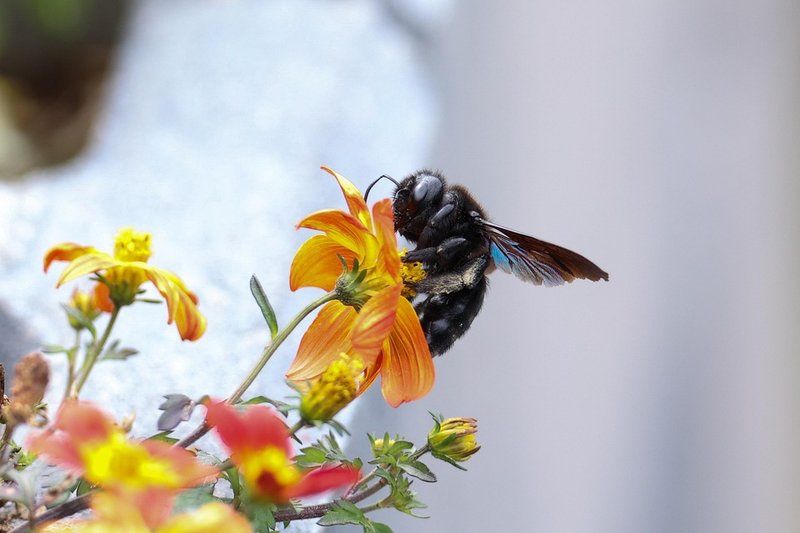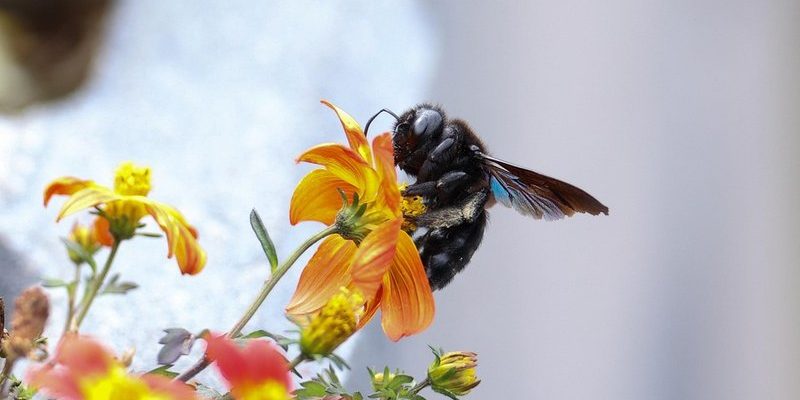
So, what exactly does a carpenter bee do? Think of them as a blend of construction worker and gardener. They not only help with pollination but also play a significant role in maintaining the health of our plants. Let’s dive deeper into their world to understand their unique contributions and discover just how important they are to our environment.
What Are Carpenter Bees?
Carpenter bees belong to the *Anthophora* family, and they are primarily found in warm areas. You might spot them buzzing around your garden, usually around springtime when wildflowers and blooming plants are plentiful. They’re often mistaken for bumblebees due to their similar size and shape, but carpenter bees generally have shiny, hairless abdomens while bumblebees appear fuzzy.
They can be identified by their distinct behavior, as they like to bore into wood to create nests. This nesting process is essential, as it serves as a home for their larvae. You may even find small holes in untreated wood like fences or trees, which are telltale signs of their presence. Honestly, while some might see this as a problem, carpenter bees are less destructive than they seem. In fact, they mostly prefer to utilize dead or decaying wood.
The Art of Pollination
You might be wondering, “What’s the big deal about pollination?” Well, here’s the thing: pollination is crucial for the reproduction of many plants. This process allows them to produce fruits, seeds, and, ultimately, new plants. Carpenter bees have a unique method of pollination that’s quite effective. When they visit flowers, they collect pollen on their bodies and transfer it to other blooms, which helps plants grow efficiently.
In contrast to honeybees, carpenter bees are solitary insects, meaning each female works alone, visiting several flowers. Their role in pollination is especially vital for certain plants, including tomatoes, peppers, and blueberries. Research has shown that carpenter bees can improve fruit yield and quality, making them a critical player in our agricultural ecosystem.
How Pollination Works
Let me explain how this fascinating process works. As a carpenter bee visits a flower, it lands on the reproductive part of the bloom to gather nectar and pollen. The bee’s body collects pollen grains, which stick to their hairy legs and bodies. When they move on to the next flower, they inadvertently transfer some of this pollen, leading to fertilization.
This is not a one-way street; flowers have adapted in ways to attract these pollinators. Bright colors, sweet fragrances, and plentiful nectar are all strategies used by plants to entice carpenter bees and other pollinators. As a result, the relationship between carpenter bees and flowers is a beautiful symbiosis, where each benefits from the other.
Carpenter Bees as Ecosystem Engineers
Carpenter bees do more than just pollinate; they also contribute to their environments in surprising ways. Their nesting habits can promote biodiversity by creating habitats for various organisms. When they bore holes into wood, it allows other insects to move in and use the space as shelter.
Moreover, these bees help to break down decaying wood, which is an important process in nutrient recycling within ecosystems. This decomposition contributes to soil health, making it richer and more fertile for plants. So, in a way, carpenter bees serve as little ecosystem engineers, modifying their environment to support life in various forms.
Creating Habitat for Other Species
When you think about it, the impact of carpenter bees goes beyond just their own species. The holes they create can provide nesting sites for other solitary bees, beetles, and even birds. Some birds, like wrens, may use abandoned carpenter bee nests as a safe place to raise their chicks. This interconnectedness highlights the importance of preserving carpenter bee populations, as their decline could lead to reduced habitat for other species as well.
In addition to insects and birds, the decomposing wood that carpenter bees work on can harbor fungi and microorganisms that play vital roles in decomposition and nutrient cycling. By maintaining the balance in their habitats, carpenter bees support a whole community of life, which is essential for biodiversity.
Common Misunderstandings About Carpenter Bees
Carpenter bees can sometimes get a bad reputation, and that’s really due to misunderstandings about their behavior and ecology. Many people worry that these bees are aggressive or that they cause significant damage to wood structures. However, it’s important to clarify a few things.
First, carpenter bees are generally not aggressive. Males, which can be more visible, tend to chase away intruders, but they don’t sting. Only females can sting, and they will only do so when they feel threatened. So, if you’re approached by a buzzing carpenter bee, know that it’s likely just curious or defending its territory rather than looking for a fight.
Second, while they do bore into wood, they prefer dead or weathered wood. Their nesting habits do not typically result in extensive damage. In fact, carpenter bees are essential pollinators and contribute positively to the environment, so managing their presence rather than eradicating them is a better approach for gardeners and homeowners alike.
Supporting Carpenter Bee Populations
So, how can you support carpenter bees and encourage their presence in your garden or yard? It’s simpler than you might think! Here are a few friendly tips:
- Plant native flowers: Carpenter bees are attracted to native blooms like sunflowers, black-eyed Susans, and lavender. These plants provide both nectar and pollen.
- Avoid chemical pesticides: These can harm not only carpenter bees but also other vital pollinators. Opt for natural pest control methods instead.
- Leave dead wood: If you have some untreated wood in your yard, consider leaving it. This can become a perfect nesting site for carpenter bees.
- Create bee houses: You can build or buy bee hotels that provide safe spaces for solitary bees to nest.
By making small adjustments to your gardening practices, you can create a welcoming environment for carpenter bees and help boost their populations. Remember, a diverse garden benefits not only these bees but also countless other species.
Carpenter bees are truly fascinating creatures that play important roles in our ecosystems. From their impressive pollination skills to their surprising contributions to soil health and biodiversity, they deserve our respect and protection. By understanding their behaviors and actively supporting their populations, we can foster a healthier environment for all living things. So, the next time you see a carpenter bee buzzing around your flowers, take a moment to appreciate the hard work they do, and remember: they’re not just buzzin’ around—they’re making the world a better place.

